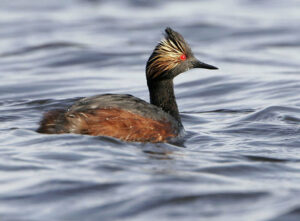
This post was written by Edith Harris, 2013 Mono Lake Intern and 2014 & 2015 Outdoor Education Instructor.
The Mono Lake Committee was recently featured on the Los Angeles Times’ Science Now blog!
As the LA Times reported on Thursday, the Committee is looking for a volunteer who is willing to help count the number of Eared Grebes that appear in photographs taken of them during their fall migratory journeys. The job is estimated to take about 40–60 hours, and will involve manually counting grebes in approximately 800 photos and then inputting this data into a spreadsheet.
Eared Grebes are small birds that are unable to walk on land because their legs, evolved for paddling and diving, are positioned very far back on their bodies. These curious creatures also need an adequate aqua-runway in order to take off into flight, and can get stuck in bodies of water that are too small to accommodate their ascent.
Nearly a million Eared Grebes arrive at Mono Lake from Mexico each year to stop for respite (and a brine shrimp buffet) on their way to Canada. It is important that fluctuations in Eared Grebe numbers be documented, as this data is one piece that fits into a larger ecological puzzle—it helps scientists determine the health of the species, gauge weather patterns, and assess the vitality of Mono’s entire ecosystem.
Interested volunteers should flock to the Mono Lake Committee in Lee Vining, or simply contact Rose Catron at (760) 647-6595.

